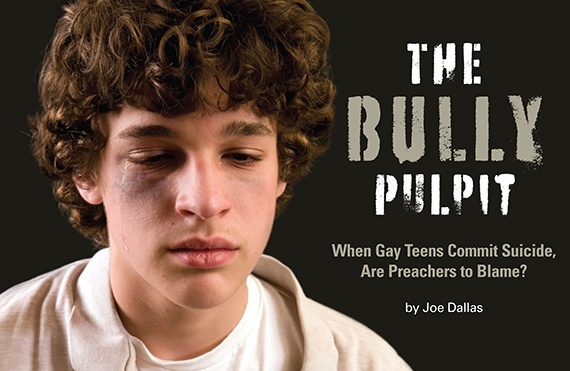This article first appeared in Christian Research Journal, volume 34, number 03 (2011). For further information or to subscribe to the Christian Research Journal go to: http://www.equip.org
SYNOPSIS
The recent tragic rash of suicides among homosexual teens, who’d been bullied by classmates and peers, has raised the question of whether Christian teaching about homosexuality inspires bullying and violence against homosexuals. Although no evidence suggests that religious teaching inspired the suicide incidents, and no evidence indicates that Christian teaching influenced the youths who bullied the homosexual teens, a number of celebrity figures have nonetheless accused pastors and Christian leaders of inspiring teens to bully gays. Because this accusation has been repeated often, and through popular media outlets, a number of people seem to believe that biblical teaching on human sexuality inspires some unstable teens to mistreat homosexuals.
These accusations can be rebutted by examining the incidents themselves, the known religious affiliations of all parties involved, the lack of cause and effect links in these cases, and what polls have to say about what does and does not influence modern teens. But it’s also essential that we examine ourselves and our rhetoric, to make certain that our message to homosexuals, and indeed to all people, is biblically balanced, clear, and respectful.
The facts are stunning, the stories behind them a baffling agony, and all the more so because they took place within a period of weeks.
On July 9, 2010, fifteen-year-old Justin Aaberg of Andover, Minnesota, hanged himself in his own bedroom. His mother claimed school bullies had frequently targeted him because of his homosexuality.1
Billy Lucas, another fifteen-year-old from Indiana, was next. His mother found him hanging from the rafters of their barn on September 9 after enduring, according to a close friend, ongoing harassment from classmates, including shouts of encouragement to “go kill himself” because he was a “fag.”2
Two weeks later, a thirteen-year-old, straight-A student from Houston, Texas, named Asher Brown followed suit. On September 23, a classmate reports, the homosexual boy was kicked down a flight of school stairs by another student, whose friend then kicked his books away from him before booting Asher down the remaining steps. The next day he used his stepfather’s 9mm Baretta to shoot himself.3
Within four days, a second thirteen-year-old’s life ended when Seth Walsh of Tehachapi, California, hanged himself in his backyard after suffering years of anti-homosexual bullying.4
And finally, in perhaps the most publicized of the cases, Rutgers University student and musician Tyler Clementi jumped off a New Jersey bridge after the nineteen-year-old’s roommate secretly videotaped Tyler’s sexual encounter with another man, then streamed the images to countless viewers over the Internet.5
The outpouring of national grief that followed was predictable and right. Lives that had barely begun were now cut short by their own hands, partly (or solely?) because they could no longer tolerate the anti-gay abuse heaped on them by peers. Talk shows, news reports, and celebrities led the way in decrying the callousness of young people whose mistreatment of fellow teenagers had induced five of them to kill themselves. Outrage was called for, and disgust over bullying was expressed far and wide.
Responsible, legitimate questions needed to be raised: What other factors, if any, played into these desperate decisions? Were there warning signs, and if so, were they ignored? Was there an increase in gay teen suicides, or were we just now becoming aware of a problem that has always been with us? Is there such a thing as a “domino effect,” by which kids become more inclined toward suicide when they hear of other kids taking their lives? And, most important, how do we prevent more of the same?
ARE CHRISTIANS TO BLAME?
Christians and non-Christians alike crave the answers, since this is a concern shared by all. In the midst of the legitimate grieving and questioning, however, accusations started flying, and not just at the bullies. Some prominent cultural figures pointed to the church, theorizing that Christian condemnation of homosexual behavior was responsible for the hatred, which inspired the bullying, which led to the deaths. We—those of us holding and promoting a traditional understanding of homosexuality—were therefore the villains.
So said comedienne Kathy Griffin in a videotaped message aired on the Internet shortly after the tragedies: “The politicians, so-called religious leaders, and pundits who have made careers out of saying that being gay is wrong or immoral or that gays are somehow less-than, they all have blood on their hands. All you anti-gay public figures, and you know who you are, you have the blood of these gay teens on your hands.”6
Griffin expanded her indictment on The Larry King Show, when she deduced that Christians and/or conservative leaders who disapprove of homosexuality have thereby influenced young people to disrespect and mistreat them: “This is trickle-down homophobia. And I really want people to connect the dots. And that’s why I believe there’s a connection between Prop 8, Don’t Ask Don’t Tell, and now this string of teen suicides.”7
Actress and comedienne Wanda Sykes seems to agree. On the same broadcast she notes, “Society has told the kids that [bullying is] OK. In the church they teach that homosexuality is wrong. They pretty much give permission to disrespect and cause harm to the gay and lesbian community.”8
King then asked Lance Bass (an openly gay singer formerly with the group NSYNC) about connections between church sermons and homophobia:
King: “Do you think these kinds of things spoken from their own Bible could lead to violence?”
Lance Bass: “It does. [Prejudice is] passed down from generation to generation. Once we finally get rid of Don’t Ask Don’t Tell; once we’re equal and everyone can get married—that’s what’s teaching our younger generation what’s right and what’s wrong.”9
And so began a new spin on the subject, one that characterized any opposition to homosexuality as complicit in the deaths we were all mourning. Suddenly the bullies weren’t the real problem. The trouble instead lay with the millions of men and women who believe, based on their biblically informed worldview, that homosexuality falls short of our Creator’s design. Repeated often enough by influential voices, this line seems to have gained widespread, if uncritical, public acceptance, as evidenced in a survey conducted by the Salt Lake City Tribune that found that two-thirds of its respondents believed that religious teaching against homosexuality inspired mistreatment of gays.10 Blogs and chat rooms were fired up by the notion, expressed most succinctly by blogger Matthew Gatheringwater, who wrote in Religion and Ethics News Weekly, “If you attend a church that preaches that homosexuality is a sin or a disorder, you are promoting hatred and giving permission to violence. If you think you can hate the so-called sin, but love the sinner, you are kidding yourself.”11
Given that a high percentage of believers do attend such churches, we now face the challenge to not only maintain and promote a Scriptural position on human sexuality, but also to defend that position against charges that it is inherently destructive. This we can do through rebuttal, reflection, and resolve.
REBUTTAL
When refuting these charges, let’s remember that the tactic behind them is nothing new. When the goals and beliefs of Group A clash with those of Group B (and when both groups are hoping to influence an undecided public), then Group B may try discrediting Group A, not by directly challenging its beliefs, but by blaming it for a current crisis. We’ve seen this scapegoating among political parties, for example, when they’ve blamed each other for economic woes or global catastrophes. Jesus experienced this when His opponents twisted His words and accused Him of plotting to tear down the temple (Matt. 26:61); and Paul was similarly charged with public disruption when his preaching interfered with local commercial and political interests in Jerusalem (Acts 21:28). In a similar vein, since the traditional Christian view of homosexuality as abnormal clashes with the gay rights movement’s goal of normalizing it, it’s no wonder some proponents of gay rights try to discredit that view by any means, no matter how inaccurate or unfair they may be.
And “inaccurate” and “unfair” are apt words because, in fact, nothing has emerged indicating religious beliefs were the cause of the bullying, as pointed out by David Gibson, religion editor for Politics Daily: “There is no evidence that those who harassed Clementi or others were chiefly or even in part influenced by religious teachings.”12
No evidence? From the confident charges leveled by Kathy Griffin, Wanda Sykes, and Lance Bass, not to mention the results of the Salt Lake City poll cited above, one would think the evidence had been clear-cut and obvious. But not only is there no confirmed link between religious teaching and these recent cases—according to the American Foundation for Suicide Prevention, it remains unclear what causes gay teen suicide in general: “Suicide attempts in this population have been linked to a variety of factors including gender non conformity, lack of support, family problems, violence/victimization, early sexual debut and mental health problems, notably depression and substance abuse or dependency. How these factors converge to produce suicidal behavior among different groups of sexual minority youth, however, remains only partially understood.”13 It is exactly that partial understanding that led the author of a primer on gay teens to conclude, “The causal link between sexual orientation and suicide has yet to be determined.”14
Still, even with the absence of hard proof, isn’t it possible that Christian teaching could influence bullies? Possible, yes, but plausible only if the bullies are proven to be regular church-going Christians (for which, in this case, there’s no evidence) or if Christian teaching in general shapes the thinking of today’s teens. After all, if church positions on homosexuality influence adolescent attitudes towards homosexuals, then it stands to reason that teens are looking to the Christian church for guidance and inspiration.
Research says otherwise, however. Far from being swayed by biblical mores, modern American youth takes its cues from other sources. A study conducted at the University of Kentucky assessed the “various sources of influence” on teens, and found that 51 percent of the respondents were primarily influenced by friends, 49 percent by parents, 31.5 percent by school, and only 19 percent by church.15 Pew research also indicates that the younger generation is “less religiously active than older Americans”16 and pollster George Barna notes, “Our continuing research among teenagers and adolescents shows that the trend away from adopting biblical theology in favor of syncretic, culture based theology is advancing at full gallop.”17
That advance shows itself clearly in the younger generation’s views on homosexuality, which stand in sharp contrast to the disrespect Sykes accused the church of foisting on them. Over a decade ago, in fact, researchers at the Journal of Extension found that 70 percent of America’s young adults aged 18–29 believed that homosexuals should be allowed to marry or have civil unions18 and George Barna found that 62 percent of the teens polled approved of similar legal recognitions for homosexual couples.19
Griffin asks us to connect the dots between Proposition 8, Don’t Ask, Don’t Tell, religious teaching on homosexuality, and gay teen suicides. But if teens in general are not influenced by biblical teachings; and if the specific teens who bullied these suicide victims are not committed Christians; and if, despite Proposition 8 and military policy on gays, modern teens are statistically more accepting of homosexuality than their adult counterparts; then exactly what picture emerges from the dots Griffin wants us to connect?
Perhaps it can be found outside the church, far from politics, and closer to the pop culture to which teenagers traditionally have more of an ear. Should she bother to look there, Griffin could find some truly disturbing dots, which, when connected, give a more accurate portrait of a real boogeyman. Evidently, most teens don’t object to homosexuality. But for those who do, the bully pulpit spewing encouragement to mistreat gays comes not from the sanctuary, but the iPod. Award-winning rapper Eminem, for example, preaches genuinely homophobic sermons that would make most Christians wince. Consider lyrics from his track titled Kill You: “I’m ready to make everyone’s throats ache. / You faggots keep egging me on ‘till I have you at knife point / Then you beg me to stop?”20 Or his rants from Criminal: “My words are like a dagger with a jagged edge / And I’ll stab you in the head whether you’re a fag or a les / Homophobic? Hey fags, the answer’s yes.”21
Eminem has plenty of company, as lyrical attacks on homosexuals have been features of rap and hip hop music for decades.22 While being appalled that this material comes from popular artists, we might also ask: who is more likely to be influencing disturbed, violent-prone teens: the conservative clergyman down the block whose church most adolescents avoid, or the man at the microphone many teens pay to hear?
This, of course, cannot account for all forms of hatred. The bullying phenomenon has always been with us, showing itself in a sick, mindless tendency to persecute the Other—the racial minority, the physically unattractive, the handicapped, the timid, the weak, the brainy, and, yes, the homosexual. As long as sin exists, it will show itself in teenage cruelty directed toward the Other, as insecure youths try to bolster their confidence at the expense of their victims. And to whatever extent we can exert a Christian influence to resist that sin and protect its targets, we must.
REFLECTION AND RESOLVE
Granted, the evidence backing charges made by Sykes and Griffin is lacking, and when the church is accused of complicity in these awful suicides, the burden of proof isn’t being met. But we cannot with integrity absolve ourselves of any unfair or unkind attitudes toward homosexuals, and here some serious reflection is called for.
Consider a Facebook posting last year by an openly Christian parent and school board member from Arkansas:
Being a fag doesn’t give you the right to ruin the rest of our lives. If you get easily offended by being called a fag then don’t tell anyone you are a fag. It p——-s me off though that we make a special purple fag day for them. I like that fags can’t procreate. I also enjoy the fact that they often give each other aids and die. —-I would disown my kids if they were gay. They will not be welcome at my home or in my vicinity. I will absolutely run them off. Of course my kids will know better. My kids will have solid Christian beliefs.23
Then reflect on the actions of a group of Christians in Missouri who, on learning in 2006 that a gay campground site was opening in their area, purchased land next to the campsite and turned it into a hog farm to express their contempt.24 And note the words of one of America’s most well-known televangelists, who predicted during a meeting that God would destroy the entire homosexual population with fire by 1995.25 (And consider, carefully, that the notion of all homosexuals dying was met with applause by the Christian audience.)
No wonder columnist and seminary president Albert Mohler, when commenting on the recent gay teen suicides, noted that pro-gay spokespersons weren’t entirely wrong in their criticisms:
When gay activists accuse conservative Christians of homophobia, they are also right. Much of our response to homosexuality is rooted in ignorance and fear. We speak of homosexuals as a particular class of especially depraved sinners—Far too many evangelical pastors talk about sexual orientation with a crude dismissal or with glib assurances that gay persons simply choose to be gay. While most evangelicals know that the Bible condemns homosexuality, far too many find comfort in their own moralism, consigning homosexuals to a theological or moral category all their own.26
And so we resolve to speak truth in love, recognizing, even as we commit ourselves to it, that the challenge is daunting. To live in consistency with the values we promote, to love when we are being reviled, and to speak with authority and humility in equal portions, requires so much more than we possess, so we ask, as did Paul to the Corinthians, “Who is sufficient for these things?” (2 Cor. 2:16)
The answer, of course, takes us back to the basics. Because when it’s all been said and done, the right response to the homosexual movement, population, and individual can be found in three simple steps: We can know the Word of God, seek the Heart of God, and express both the Word and Heart of God to the homosexual. If we resolve to do this, diligently and consistently, we cannot fail.
Joe Dallas is the program director of Genesis Counseling in Tustin, California, a Christian counseling service to men dealing with sexual addiction, homosexuality, and other sexual/relational problems. He is a member of the American Association of Christian Counselors and is the author of five books on human sexuality, including his latest book, The Complete Christian Guide to Understanding Homosexuality (Harvest House, 2010).
NOTES
- David Crary, “Suicide Surge: Schools Confront Anti-Gay Bullying,” msnbc.com, October 9, 2010, http://www.msnbc.msn.com/id/39593311/ns/us_news-life/.
- Karen Hensel, “Teen Suicide Victim Hangs Himself from Barn Rafters,” wishtv.com, September 15, 2010, http://www.wishtv.com/dpp/news/local/east_central/teen-suicide-victimhangs-himself-from-barn-rafters.
- Peggy O’Hare, “Parents Say Bullies Drove Their Son to Take His Life,” Houston Chronicle, September 29, 2010, http://www.chron.com/disp/story.mpl/metropolitan/7220896.html.
- Edecio Martinez, “Gay 13-Year-Old Hangs Self after Reported Bullying,” CBS News.com, September 29, 2010, http://webcache.googleusercontent.com/search?q=cache:oVBkfbe4IrQJ:www.cbsnews.com/8301-504083_162-20018025-504083.html+seth+walsh&cd=1&hl=en&ct=clnk&gl=us.
- Emily Friedman, “Victim of Secret Dorm Sex Tape Posts Facebook Goodbye, Jumps to His Death,” abcnews.com, http://abcnews.go.com/US/victim-secret-dorm-sex-tape-commitssuicide/story?id=11758716.
- http://lybio.net/kathy-griffin-message/people/.
- Kathy Griffin, interview by Larry King, Larry King Live! October 4, 2010, transcript available at http://transcripts.cnn.com/TRANSCRIPTS/1010/04/lkl.01.html.
- Ibid.
- Ibid.
- CNN Belief Blog, October 21, 2010, http://religion.blogs.cnn.com/2010/10/21/churchescontribute-to-gay-suicides-most-americans-believe/.
- Bob Abernethy and Kim Lawton, “Religious Responses to Anti-Gay Bullying,” pbs.org, October 15, 2010, http://www.pbs.org/wnet/religionandethics/episodes/october-15-2010/religious-responses-to-anti-gay-bullying/7274/.
- David Gibson, “Gay Bullying Deaths and Religion: Are Believers the Problem or the Solution?” Politics Daily, http://www.politicsdaily.com/2010/10/07/gay-bullying-deaths-andreligion-are-believers-the-problem-or-t/.
- http://www.afsp.org/index.cfm?page_id=6FB9BA00-7E90-9BD4-C33BD398EAAE73C0.
- Katy Abel, “Understanding Your Gay Teen,” http://life.familyeducation.com/teen/sexuality/36545.html.
- Studies by Hundleby et al., cited at: http://www.joe.org/joe/1990fall/rb3.php.
- http://pewforum.org/Age/Religion-Among-the-Millennials.aspx#social.
- “Americans Draw Theological Beliefs from Diverse Points of View,” Barna Research Online, October 8, 2002; http://www.barna.org/barna-update/article/5-barna-update/82-americansdraw-theological-beliefs-from-diverse-points-of-view?q=october+2002
- “Influences on Teen Decisions,” Journal of Extension 28, 3 (Fall 1990), Research in Brief, 3RIB3 (CIRCLE Fact Sheet, February 2005), http://docs.google.com/viewer?a=v&q=cache:gKnwJ9pVYKwJ:www.sbacs.org/docs/alarming.pdf+statistics+on+church+influence+on+teenagers&hl=en&gl=us&pid=bl&srcid=ADGEEShGFwkyXHVnBAZP_5dTQMbUjZMZW2RIZhnS6CS2nCPYd9mDG6k5hjFUHXLljy8DFyKjMp6emUrySq-KkH9yEb9kMU8derrsqRNxMi25x3_nunMStqufxXRyiDn7cUIEIVgpmcxW&sig=AHIEtbTEp6rL6bL8O—dkFA-xZNa5p992g.
- George Barna, Real Teens (Ventura, CA: Regal Books: 2001), 59.
- Kevin Choi, “Eminem’s Slim, Shady Lyrics,” http://tech.mit.edu/V121/N5.5/col06choi.5.5c.html.
- Ibid.
- Christopher Weingarten, “So Just How Homophobic Is Rap in 2010?” The Village Voice, July 29, 2010, http://blogs.villagevoice.com/music/2010/07/so_just_how_hom.php.
- Alex Eichler, “Homophobic Diatribe Sinks Arkansas School Board Member,” The Atlantic Wire, October 29, 2010, http://www.theatlanticwire.com/opinions/view/opinion/Homophobic-Diatribe-Sinks-Arkansas-School-Board-Member-5575.
- “Appalling Meanness in Missouri,” Jews on First, July 18, 2006, http://www.jewsonfirst.org/06b/cactuscanyon.htm.
- Transcript of sermon by Benny Hinn, http://www.sherrytalkradio.com/hinn/index.htm.
- Albert Mohler, “Between the Boy and the Bridge: A Haunting Question,” AlbertMohler.com, http://www.albertmohler.com/2010/10/04/between-the-boy-and-the-bridge-a-hauntingquestion/.









